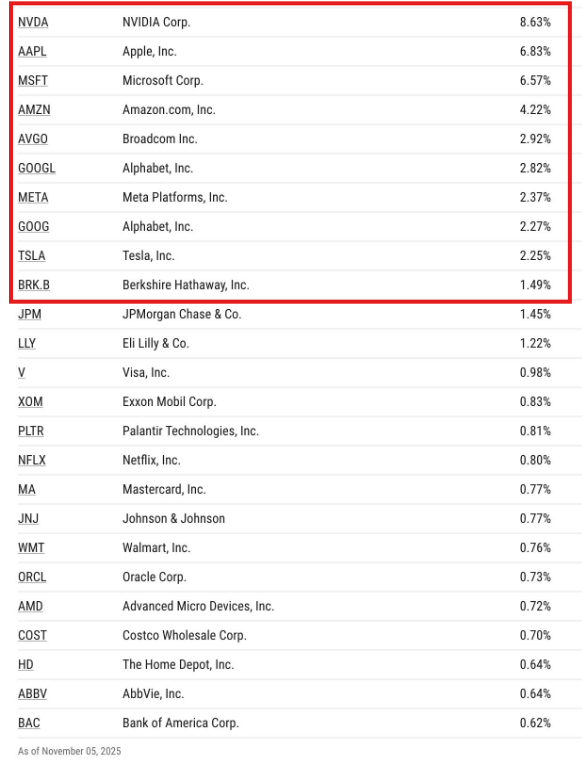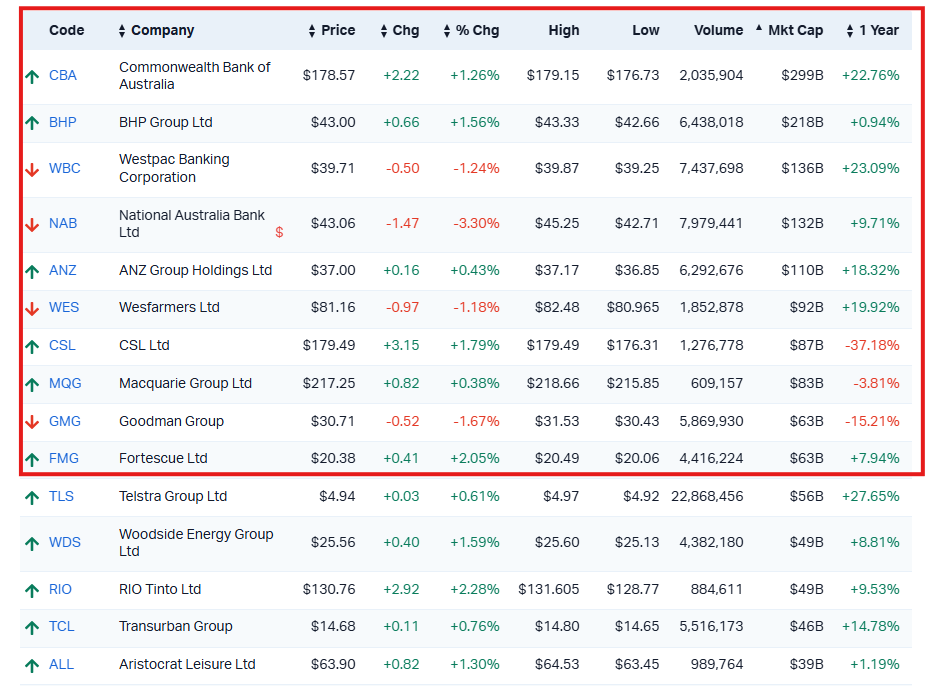What if I told you that US markets aren’t that concentrated?
Can people please do me a favour and stop telling me I should be in the ASX 200 because there’s too much market concentration in the S&P 500?
There is little doubt that US markets have become more concentrated. The top 10 companies represent just over 40% of the S&P 500’s total market cap, up from around 25% just 15 years ago. But why did that happen? Well, it happened because the companies inside the top 10 of the S&P 500 all have fantastic forward-facing enterprises, with strong sales growth, solid margins, reliable and significant cash flow, and bullet-proof balance sheets, wrapped in high-moat business models.
Most importantly, net income is up almost across the board, and every single company, including Berkshire Hathaway, has a meaningful exposure to future growth drivers like automation, robotics, AI, cloud, broader tech, and the like.
In its most recent earnings report, Broadcom (the 6th biggest company in the S&P 500, that likely many people either haven’t heard of or know very little about) grew Q3 sales 22% year-on-year to just shy of US$16.0B, and guided growth in their next period’s sales up by 24%, to US$17.4B. They are quarterly numbers, not annual.
That's why these stock values are rising.

Now, contrast the ASX 200. The top 10 companies represent 51% of the index, and 7 of the top 10 are banks and miners that have structural barriers to genuine growth. BHP sales are down over 5 years, profits are too. And CBA sales are up slightly but that alone has (or had, at least) turned them into the most expensive bank on the planet. The other big 3 banks have been less than stellar, to be charitable, although Westpac has been better.
Valuations follow earnings, and earnings follow operational leverage (that’s sales growing faster than costs). Being a price-taker in a commodity market makes it tough to get consistent operational leverage.

It is quite remarkable how many people -- clients, prospective clients, fund managers, investors, other advisers, professional partners, other punters - - are constantly trying to counsel me, once they hear my views around the US being at the centre of growth portfolios that I build, that what I need to do is to buy Australian equities to diversify away from concentration risk. And if it isn't Australian equities, although it most often is, that I need to buy some other market.
Given it is indeed most often Australia, let's compare some market concentration metrics:
| ASX 200 | S&P 500 | |
| Top 2 | 20% of the index | 15% |
| Top 5 | 35% | 29% |
| Top 10 | 51% | 40% |
| Sales up? | Maybe | Yes |
| Profits up? | Not really | Yes |
| Cyclical? | More | Less |
Granted that the S&P 500 is somewhat single industry focused, but the ASX 200 is 81% banks and miners. Not sure you can make the argument that the solution for S&P 500 concentration is the ASX 200. And you can see it here below too, given how quickly the market cap column drops off from 2nd place (BHP) to 3rd place (Westpac), and also from 4th place (NAB) to 6th place (Wesfarmers).

Let’s take a look at some other international markets, while we’re at it. Here is the percentage that the top 10 stocks represent of their national index:
| Market | Top 10 | Comments |
| Japan - Nikkei 225 | 40% | price weighted |
| New Zealand - NZX 50 | 67% | was 53% a decade ago |
| Taiwan - TWSE | 52% | one stock (TSMC) drives the market |
| South Korea - KOSPI | 56% | one stock (Samsung) drives the market |
| Germany - DAX | 64% | heavy on industrials |
| France - CAC 40 | 61% | somewhat diversified |
| UK - FTSE 100 | 58% | lots of banks and value stocks |
| Hong Kong - Hang Seng | 60% | lots of banks and some tech |
| Canada - TSX Composite | 54% | looks a lot like Australia |
The truth is, all global markets are a little concentrated, and they actually have been for a while. Over time, it's only a relatively small number of stocks that deliver the outsized returns we're somewhat used to in post-war global stock markets. Good news though – if you insist on not being concentrated, you can go to the Shanghai Stock Exchange Composite index where for the top 10, you’ll be down to between 30% and 35%, with most of that exposure being state-owned enterprises. Or you can go to Argentina where the top 10 stocks make up almost 75% of the index.
How good!! Please....
Again, I’m not asserting that the US markets aren't concentrated, or that they haven't become more concentrated over time. They are, and they have.
However, this idea that the US is a remote island of index concentration in a global sea of broad index diversification is simply rubbish. Moving out of a so-called concentrated position simply for the academic sake of moving, and to deliver you an ephemeral good feeling about not being so concentrated, makes little sense to me if it results in markedly reduced risk-adjusted returns. Especially given your options are likely also concentrated.
To make sure this is very clear - valuations are concentrated because the current earnings power is concentrated. The top 10 companies in the S&P 500 have accounted for between 40% and 50% of earnings for the last 5 years. It was traditionally more like mid-20%.
That's markets working - - higher earnings power is supposed to deliver higher valuations.
But back closer to home - - can people please do me a favour and stop telling me I should be in the ASX 200 because there’s too much market concentration in the S&P 500? Thank you….
Good luck out there.

5 topics
